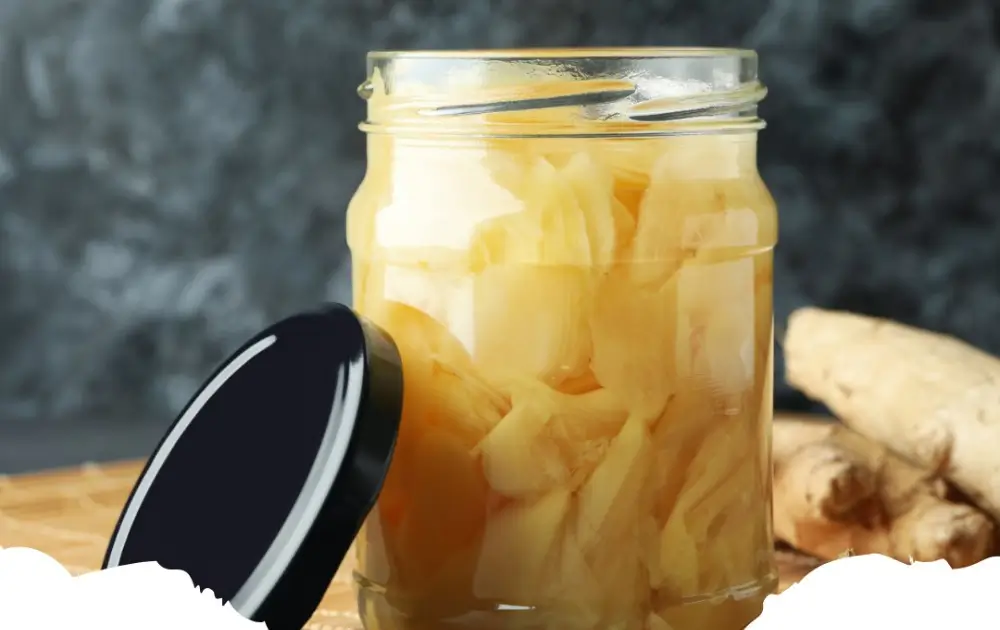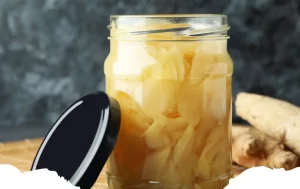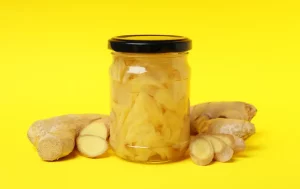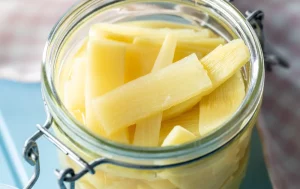Pickled Ginger, often known as Gari in Japanese cuisine, is a staple condiment that accompanies sushi and sashimi. This delicately sweet and slightly spicy treat is not only cherished for its ability to cleanse the palate between bites of sushi but also for its health benefits, including aiding digestion. The process of pickling transforms the sharpness of fresh ginger into a more mellow and complex flavor, making it an intriguing addition to various dishes.
Print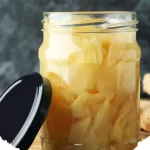
Pickled Ginger
- Author: recipstep
- Total Time: 20 minutes
- Yield: About 2 cups 1x
- Diet: Vegan
Description
Pickled Ginger, known as Gari in Japanese cuisine, is a sweet, thinly sliced young ginger that has been marinated in a solution of sugar and vinegar. Often served with sushi to cleanse the palate, this condiment is valued for its digestive benefits and its unique blend of sweet and tangy flavors.
Ingredients
3–4 Ginger roots, young or regular
2 1/2 teaspoons Salt, divided
1 cup (240ml) Rice vinegar
1/2 cup + 2 tablespoons (125g) Sugar
Instructions
Peel and Slice Ginger:
Using the back of a spoon or a peeler, peel the ginger.
Then, using a sharp knife or a mandolin, cut the ginger as thinly as possible.
Salt the Ginger:
Place sliced ginger in a bowl, sprinkle 2 teaspoons of salt, mix well and set aside for 15-20 minutes. This helps remove moisture.
Blanch the Ginger:
Meanwhile, bring a pot of water to a boil.
When boiling, add the ginger and blanch for 2-3 minutes.
Drain the ginger and allow it to cool, then squeeze out as much water as possible.
Prepare Vinegar Mixture:
In a small saucepan, combine rice vinegar, sugar, and 1/2 teaspoon of salt.
Bring the mixture to a boil, cooking for a few minutes until the sugar has dissolved.
Remove from heat and allow it to cool slightly.
Combine Ginger and Vinegar:
Place the blanched ginger in a sterilized airtight jar.
Pour the cooled vinegar mixture over the ginger.
Allow the mixture to cool completely, then seal the jar with a lid.
Refrigerate:
Refrigerate the pickled ginger for at least one day before consuming.
Note:
Keep pickled ginger in an airtight container and store in the refrigerator for up to 6 months.
Always use clean utensils to pick pickled ginger if you want to keep it for a long time.
Notes
- The ginger will naturally turn pink if you use young ginger; older ginger will not change color.
- Adjust the sugar and vinegar ratios according to taste for a sweeter or more tangy pickled ginger.
- Prep Time: 15 minutes
- Cook Time: 5 minutes
- Category: Condiment
- Method: Pickling
- Cuisine: Japanese
Nutrition
- Calories: Approximately 20 per tablespoon
- Sugar: 4.9g
- Sodium: 150mg
- Fat: 0g
- Carbohydrates: 5g
- Protein: 0g
FAQs About Homemade Pickled Ginger
Can I use any type of ginger for making pickled ginger? Yes, but for the best results, young ginger with a thin skin is recommended due to its tender texture and milder flavor, which is ideal for pickling.
How long does homemade pickled ginger last? Properly stored in an airtight container in the refrigerator, homemade pickled ginger can last up to six months. Its flavor may even improve with time.
Is it necessary to peel the ginger before pickling? While young ginger can be pickled with its skin on due to its thinness, peeling it is generally recommended to ensure a smoother texture and more uniform pickling.
Can I adjust the sweetness or acidity of the pickled ginger? Absolutely! Feel free to adjust the amount of sugar or vinegar in the pickling solution to suit your taste preferences.
What’s the purpose of blanching ginger before pickling? Blanching ginger before pickling softens it slightly, ensuring that it fully absorbs the flavors of the pickling solution and becomes tender.
Gathering Your Ingredients
To make Pickled Ginger at home, you’ll need a few simple ingredients:
-
- 1 pound fresh young ginger (for its tender texture and mild taste)
- 1 cup rice vinegar
- 3/4 cup sugar
- 1 teaspoon salt
Preparing the Ginger
Begin by peeling the ginger and slicing it as thinly as possible. The key to perfect Pickled Ginger lies in the thinness of the slices; the thinner, the better. Use a mandoline slicer for consistent and ultra-thin slices.
Pickling Process
- Blanch the ginger slices in boiling water for about 30 seconds to soften them slightly. Then, immediately plunge them into ice water to halt the cooking process.
- In a saucepan, combine the rice vinegar, sugar, and salt. Heat the mixture until the sugar and salt have dissolved.
- Place the drained ginger slices in a clean jar. Pour the hot vinegar mixture over the ginger, ensuring the slices are fully submerged.
- Allow the jar to cool to room temperature before sealing it and refrigerating. The ginger will begin to take on a natural pink hue as it pickles.
Notes for Optimal Flavor
- Pickled Ginger develops its flavors over time. For the best taste, let it sit in the refrigerator for at least a week before using.
- The pink color is more prominent when using young ginger. Older ginger may not achieve the same natural pink, but the taste will still be delightful.
Serving Suggestions
Pickled Ginger is traditionally served with sushi, but its uses are versatile. It can add a zesty note to salads, be a refreshing side to grilled meats, or even enhance cocktails and desserts.
Storing Pickled Ginger
Properly stored in an airtight container in the refrigerator, Pickled Ginger can last for several months. Its flavor intensifies over time, offering a more profound taste experience the longer it sits. Enjoy the nuanced flavors of homemade Pickled Ginger and the satisfaction of having crafted this beloved Japanese condiment right in your own kitchen.
Exploring Health Benefits
Pickled Ginger not only adds a burst of flavor to dishes but also comes with an array of health benefits. Rich in antioxidants and known for its anti-inflammatory properties, pickled ginger aids in digestion, helps soothe nausea, and may even boost the immune system. Incorporating this tangy condiment into your diet can be a delicious way to promote overall well-being.
Creative Culinary Uses
Beyond its role as a sushi accompaniment, Pickled Ginger can be a versatile ingredient in your culinary repertoire. Try chopping it up and adding it to coleslaw or salads for an unexpected zing. It can also be used as a garnish on seafood dishes, mixed into dressings, or even incorporated into marinades to impart a unique flavor profile to meats and vegetables.
Making Pickled Ginger Your Own
While traditional recipe is made with simple ingredients, don’t hesitate to customize the recipe to suit your taste. Experiment with adding other spices, such as star anise or cinnamon sticks, to the pickling liquid for a different flavor twist. Adjusting the sugar and vinegar ratios can also help you find the perfect balance of sweetness and acidity to match your palate.
The Art of Gifting Pickled Ginger
Homemade Pickled Ginger makes for a thoughtful and unique gift, especially for food enthusiasts who appreciate the finer details of Asian cuisine. Package it in decorative jars with custom labels for a personal touch. Sharing your homemade Pickled Ginger is a wonderful way to spread culinary joy and introduce friends and family to the delights of this traditional Japanese condiment.
Embracing the Tradition and Innovation
As you delve into the world of making this recipe, you’re participating in a tradition that dates back centuries while also embracing the spirit of culinary innovation. This simple yet profound condiment represents the harmony of taste and health, and making it at home allows you to infuse your personal touch into every jar. Whether you’re a seasoned sushi connoisseur or a curious cook looking to expand your flavor horizons, homemade Pickled Ginger offers a world of taste experiences waiting to be explored.
Mastering the Texture for Perfect Pickled Ginger
Achieving the perfect texture in this recipe is crucial for that authentic melt-in-your-mouth experience. The secret lies in slicing the ginger as thinly as possible, a task where a sharp knife or a mandoline slicer becomes invaluable. Thin slices not only absorb the pickling solution more effectively but also ensure the ginger is tender and easy to eat, enhancing the overall enjoyment of the condiment.
Seasonal Variations and Their Impact
The season in which ginger is harvested can significantly impact the quality and flavor of your recipe. Young ginger, typically harvested in the spring, is more tender and has a milder flavor, making it ideal for pickling. Its skin is thinner and easier to peel, and it often results in a more vibrant pink hue once pickled. Seeking out seasonal ginger can make a noticeable difference in the final product, highlighting the importance of ingredient quality in traditional pickling recipes.
The Role of Pickled Ginger in a Balanced Diet
Incorporating this recipe into your meals can contribute to a balanced diet. Its digestive benefits and low calorie count make it an excellent addition to healthy eating plans. Furthermore, ginger’s natural properties can stimulate the palate, making it easier to enjoy a wide range of nutritious foods. Including Pickled Ginger as a regular part of your diet can add both flavor and health benefits to your daily meals.
Cultural Significance and Global Appeal
Pickled Ginger’s roots in Japanese cuisine reflect a deep cultural significance, embodying principles of harmony, balance, and attention to detail. As this condiment gains popularity worldwide, it serves as a bridge between cultures, inviting people everywhere to appreciate the subtleties of Japanese culinary traditions. The global appeal of this recipe is a testament to the universal language of food and its power to connect diverse communities through shared tastes and experiences.
Expanding Culinary Horizons with the recipe
Embracing Pickled Ginger in your cooking is an opportunity to expand your culinary horizons. Its unique flavor profile can inspire creativity in the kitchen, challenging you to explore new recipes and cooking techniques. From traditional sushi accompaniments to innovative fusion dishes, it can elevate ordinary recipes to extraordinary culinary creations. Engaging with this versatile ingredient encourages a spirit of exploration and experimentation, enriching your cooking journey with each dish.
Celebrating Sustainability Through Homemade Pickled Ginger
Creating homemade Pickled Ginger not only allows for customization but also promotes sustainability. By preparing this condiment in your own kitchen, you reduce the need for commercially packaged products, cutting down on packaging waste and the carbon footprint associated with transport. Additionally, sourcing ingredients locally or opting for organic ginger further enhances the environmental benefits, showcasing how traditional culinary practices can align with modern eco-conscious values.
Enhancing Culinary Education with Pickled Ginger
Diving into the process of making Pickled Ginger serves as an excellent culinary education tool. It introduces chefs and home cooks to the fundamentals of pickling, a preservation method with a rich history across many cultures. This experience deepens understanding of flavor development, the chemistry behind preservation techniques, and the importance of ingredient selection, providing valuable skills that are transferable to a wide range of culinary endeavors.
Fostering Community Through the Art of Pickling
The art of pickling, exemplified by the preparation of this recipe, has the power to foster community. Sharing the fruits of your labor, exchanging recipes, and hosting pickling workshops can bring people together over a shared interest in food preservation and culinary arts. This communal aspect of cooking highlights the role of food in building connections, encouraging the exchange of knowledge, and strengthening bonds within communities.
Leveraging Pickled Ginger for Health and Wellness
Incorporating this recipe into diets offers numerous health and wellness benefits, from aiding digestion to serving as a low-calorie flavor enhancer. Its preparation encourages the consumption of natural, minimally processed foods, aligning with holistic approaches to health. As more individuals seek out foods that support well-being, homemade Pickled Ginger stands out as a simple, yet effective, addition to health-conscious diets.
Pickled Ginger: A Gateway to Global Cuisine Exploration
Finally, homemade Pickled Ginger acts as a gateway to the exploration of global cuisines. Its association with Japanese culinary traditions provides an entry point for discovering other dishes and cooking techniques from Japan and beyond. As palates become more adventurous, seeking authenticity and depth of flavor, this recipe invites food enthusiasts to explore the rich tapestry of world cuisines, one bite at a time. This journey not only broadens culinary horizons but also fosters a deeper appreciation for the diversity and complexity of global food traditions.
Conclusion
Homemade pickled ginger, with its vibrant taste and health benefits, is a versatile condiment that enhances a wide variety of dishes. Making it at home allows for customization in flavor and contributes to a sustainable lifestyle by reducing packaging waste. Beyond its culinary uses, pickled ginger offers a window into the rich traditions of Japanese cuisine and invites exploration into the art of pickling. Whether you’re a seasoned chef or a curious cook, embracing the craft of making pickled ginger is a rewarding endeavor that adds depth and excitement to your culinary adventures.

